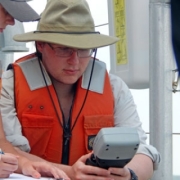Eight students will be presenting the summer work at the Ocean Sciences Meeting in March 2022!
Our Students and Their Research

You may search for students by class year and keywords found in the student's name, university, project title or abstract. Our first class was in 1989.

Location: Chesapeake Biological Laboratory
Project: Microbial Activity and Abundance Along Land Use Gradients in Chesapeake Bay Watersheds

Mentors: Jeffrey Cornwell, Ph.D.
Location: Horn Point Laboratory
Project: Locating the Source of Denitrification in a Restored Oyster Reef

Mentors: Michael Gonsior, Ph.D.
Location: Chesapeake Biological Laboratory
Project: Time-Resolved Photochemistry of Marine Fluorescent Dissolved Organic Matter

Mentors: Louis Plough, Ph.D.
Location: Horn Point Laboratory
Project: Consequences of Diversification Among Acartia tonsain the Chesapeake Bay

Mentors: Thomas Miller, Ph.D.
Location: Chesapeake Biological Laboratory
Project: Determination of the Mineral Composition of Blue Crab (Callinectes sapidus) Carapace: Assessment of Spatial Variability and Response to Acidification in the Patuxent River, Chesapeake Bay

Mentors: Patricia Glibert, Ph.D.
Location: Horn Point Laboratory
Project: Response of Phytoplankton Community to Nutrient Quality and Quantity Change in Two Coastal Lagoons, Florida Bay and Maryland/Virginia Coastal Bays

Mentors: Laura Lapham, Ph.D.
Location: Chesapeake Biological Laboratory
Project: Method Development for Field Measurements of Water-Air Methane Flux in Relation to Invasive Species Phragmites australis

Mentors: Michael Williams, Ph.D.
Location: Chesapeake Biological Laboratory
Project: Factors Responsible for the Development of Fe Flocculate in Streams with and without Regenerative Stormwater Conveyance (RSC) Structures

Mentors: Christopher Rowe, Ph.D.
Location: Chesapeake Biological Laboratory
Project: Measured Responses of Gray Tree Frog (Hyla versicolor) Tadpoles to Selenomethionine and Selenium Dioxide

Mentors: Judy O'Neil, Ph.D.
Location: Horn Point Laboratory
Project: Factors Affecting Cyanobacterial Ecology in a Restoration Wetland on Poplar Island, Chesapeake Bay

Mentors: Lora Harris, Ph.D.
Location: Chesapeake Biological Laboratory
Project: The Effects of Nutrients on the Biomechanics of Spartina alterniflora on Poplar Island

Mentors: Larry Sanford, Ph.D.
Location: Horn Point Laboratory
Project: Characterizing Flow at the Susquehanna Flats

Mentors: William Boicourt, Ph.D.
Location: Horn Point Laboratory
Project: Wind-induced Lateral Circulation and Mixing in the Chesapeake Bay

Mentors: Laura Lapham, Ph.D.
Location: Chesapeake Biological Laboratory
Project: The Microbial Effects of the Addition of Oil to the Anoxic Layers of Benthic Sediments from the Chesapeake Bay

Mentors: Andrew Heyes, Ph.D.
Location: Chesapeake Biological Laboratory
Project: Bioaccumulation of Synthetic Musk Fragrances in Northern Diamondback Terrapins (Malaclemys terrapin terrapin) of Jamaica Bay, New York, USA

Mentors: Michael Wilberg, Ph.D.
Location: Chesapeake Biological Laboratory
Project: Modeling of Blue Crab Catchability in Chesapeake Bay using Winter Dredge Surveys

Mentors: Halimeda Kilbourne, Ph.D.
Location: Chesapeake Biological Laboratory
Project: Calibration of Modern Coral Climate Signals to Ensure Accuracy of Paleoclimate Determinations in Anegada, British Virgin Islands

Mentors: Michael Gonsior, Ph.D.
Location: Chesapeake Biological Laboratory
Project: Marine Chromophoric Dissolved Organic Matter Distribution in the Atlantic Ocean

Mentors: Patricia Glibert, Ph.D.
Location: Horn Point Laboratory
Project: Effects of N:P Ratio Variation on Feeding of Dinoflagellate K. veneficum on Cryptophyte Rhodomonas sp.

Mentors: Cindy Palinkas, Ph.D.
Location: Horn Point Laboratory
Project: The Evaluation of Basic Calculations Concerning the Effects of Non-Storm Waves on Offshore Sediment at Jefferson-Patterson Park, MD



